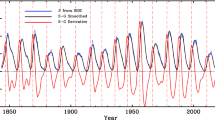Abstract
In a previous communication, the annual mean sunspot number time series for the period 1700–1990 A.D. was studied through fitting with exponential functions of the form N=No.exp(Kt) for each phase. In this letter every solar cycle is reduced to five characteristic parameters: exponents K and observed durations for the rising and declining phases and values of the maximum. The periodicities between 50 and 200 yr for these five parameters are analyzed and compared between themselves, showing similar patterns (dominating periodicities at about 59 and 86 yr) and differences such as different periods for the exponent of the rising (83.5 yr) and declining (105 yr) phase and for the observed maximum (99 yr).
Similar content being viewed by others
References
Kane, R. P. and Trivedi, N. B.: 1991, Pageoph. 135, 463.
MacDonald, G. J.: 1989, Rev. Geophys. 27, 449.
Nordemann, D. J. R.: 1992a, Solar Physics, 141, 199.
Nordemann, D. J. R.: 1992b, INPE Report. INPE-5420-PRE/1762.
Wolberg, J. R.: 1967. Prediction Analysis. Van Nostrand.
Author information
Authors and Affiliations
Rights and permissions
About this article
Cite this article
Nordemann, D.J.R., Trivedi, N.B. Sunspot number time series: Exponential fitting and periodicities. Sol Phys 142, 411–414 (1992). https://doi.org/10.1007/BF00151466
Received:
Issue Date:
DOI: https://doi.org/10.1007/BF00151466



